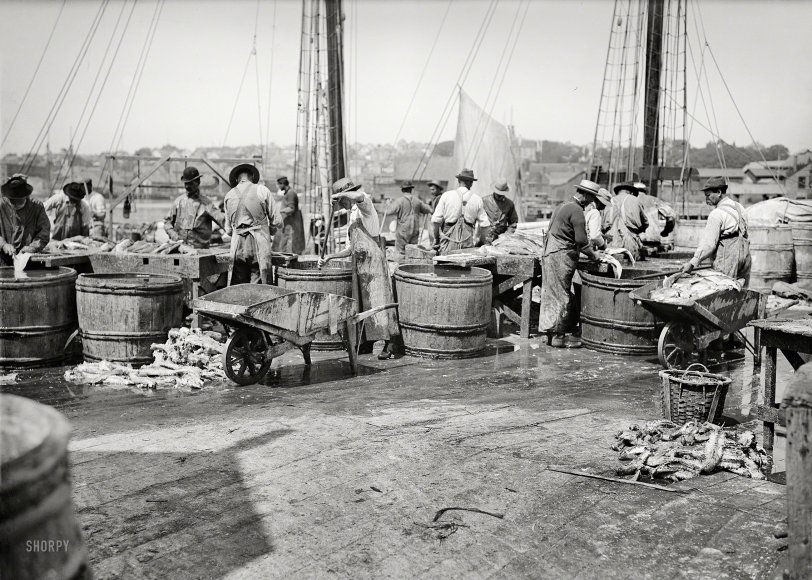


Framed or unframed, desk size to sofa size, printed by us in Arizona and Alabama since 2007. Explore now.
Shorpy is funded by you. Patreon contributors get an ad-free experience.
Learn more.

- Tough Guys
- Lost in Toyland
- And without gloves
- If I were a blindfolded time traveler
- Smoke Consumer Also Cooks
- Oh that stove!
- Possibly still there?
- What?!?
- $100 Reward
- Freeze Frame
- Texas Flyer wanted
- Just a Year Too Soon
- WWII -- Replacing men with women at the railroad crossing.
- Yes, Icing
- You kids drive me nuts!
- NOT An Easy Job
- I wonder
- Just add window boxes
- Icing Platform?
- Indiana Harbor Belt abides
- Freezing haze
- Corrections (for those who care)
- C&NW at Nelson
- Fallen Flags
- A dangerous job made worse
- Water Stop
- Passenger trains have right of way over freights?
- Coal
- Never ceases to amaze me.
- Still chuggin' (in model form)
Print Emporium
Fish in a Barrel: 1903

Gloucester, Massachusetts, circa 1903. "Handling a cargo from the fishing banks." 5x7 inch dry plate glass negative, Detroit Publishing Company. View full size.
Cleaning Fish for Market
Here you see fish being cleaned. The waste is thrown into water held in barrels. This is typical of all seaports in the Northeast.
[These are Gorton's codfish, which will be dried and cured after being salted in the barrels. The waste, as we can see in the photo, goes on the ground. - Dave]
Could be family
During the 1860's till now have had tons of family working in that industry. Back breaking work though safer on the docks than on the ships. Need to enlarge this photo and check against some old family photos, could possibly be a relative or two there.
Expert Fish Splitters
The Boston Cooking-School Magazine, Jan 1912.Catching and Curing the Codfish
By Albert Cook Church
The fame of Gloucester and her fisheries is world-wide, although to many the various ways of catching and curing fish preparatory for market are entirely unfamiliar. To thoroughly explain the methods employed would require much more space than is available, and for this reason we shall consider only those of greatest importance, first touching briefly upon the manner in which the catch is secured.
…After they are caught, the cod are transferred to the vessel, the men pitching them over the rail on deck, where they are dressed and rinsed clean, then packed in ice below, and when the vessel accumulates a catch of sufficient bulk for running to market, fishing is discontinued and all sail made, in order to reach port as quickly as possible. As a rule, vessels of the fresh fishing fleet run for the Boston market at T wharf, where the later caught and freshest fish are disposed of for higher prices than the majority of the catch brings. However, as at present we are considering the curing of the cod, let us go on with the vessel to Gloucester, where the splitters are eagerly awaiting our arrival.
…The fish are hoisted out in baskets, swung to the wharf, and overturned, where they are culled out according to length, and classified as large fish, if twenty-two inches or over, mediums between twenty-two and sixteen, all under that being designated as snappers. The culling is done by testing the length in a V shaped wooden trough, open at one end and having a thole pin or cross piece at the other.
…A good splitter can do about two hundred and fifty mediums per hour, and to one who has never seen the skillful manner in which tremendous quantities of fish are handled in Gloucester, it is a genuine revelation to see these experts perform. With almost incredible rapidity they split tons and tons of fish, and all day long they keep it up, pausing occasionally to sharpen their knives, till before nightfall they are completely surrounded with heaps of backbones and heads of fish.
Unless too small, the codsheads are taken to other benches, where the tongues and cheeks are cut out to be salted, and the three-cornered strips of backbone, to which the sounds are attached, are saved and the sounds are stripped off. These, too, are salted, as cod tongues, cheeks and sounds are considered a great delicacy. The remaining refuse, consisting of heads and backbones, is thrown into large iron cans and removed later to the glue factories, where it is used in the manufacture of fish glue.
























On Shorpy:
Today’s Top 5